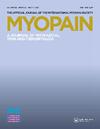The “Bodily Pain” Scale of the Short Form-36 Questionnaire is a Predictor of Outcome in Patients who Receive Ultrasound-Guided Corticosteroid Injection for Plantar Fasciitis—A Preliminary Study
引用次数: 2
Abstract
Abstract Objectives: Ultrasound-guided corticosteroid injection is an effective treatment for plantar fasciitis. We aimed to examine whether the eight scales of the Short Form-36 [SF-36] quality of life questionnaire could predict outcome of ultrasound-guided corticosteroid injection for plantar fasciitis. Methods: Sixteen patients [mean age 55.7 years] with unilateral plantar fasciitis received ultrasound-guided corticosteroid injections and all evaluations. The SF-36 questionnaire was administered and tenderness threshold [TT] was measured before injection, at 3 weeks, and at 3 months post-injection. Differences in the eight SF-36 scales among the three time points were examined. Furthermore, baseline measurements and changes in the SF-36 scales were examined for their association with changes in TT at 3 weeks and 3 months post-injection. Results: The scale “bodily pain” [BP] decreased significantly after injection [baseline versus 3 months post-injection: 46.25 ± 11.73 versus 63.06 ± 18.26; p = 0.036]. Baseline BP correlated with change in TT at 3 weeks [r = −0.554, p = 0.026]. The change in BP correlated with change in TT at 3 weeks [r = 0.594, p = 0.015] and at 3 months [r = 0.536, p = 0.032]. Conclusion: The BP scale can be used to predict the outcome of ultrasound-guided corticosteroid injection for plantar fasciitis. Less initial bodily pain leads to less improvement in objective inferior heel tenderness.短表36问卷中的“身体疼痛”量表可预测超声引导下皮质类固醇注射治疗足底筋膜炎患者的预后——一项初步研究
目的:超声引导下皮质类固醇注射是治疗足底筋膜炎的有效方法。我们的目的是研究SF-36生活质量问卷中的8个量表是否可以预测超声引导下足底筋膜炎皮质类固醇注射的结果。方法:16例单侧足底筋膜炎患者(平均年龄55.7岁)接受超声引导下皮质类固醇注射并进行评价。注射前、注射后3周和注射后3个月分别进行SF-36问卷调查和压痛阈值[TT]测量。研究了三个时间点间8个SF-36量表的差异。此外,基线测量和SF-36量表的变化检查了它们与注射后3周和3个月TT变化的关系。结果:注射后“躯体疼痛”量表[BP]明显降低[基线比注射后3个月:46.25±11.73比63.06±18.26;p = 0.036]。基线血压与3周时TT变化相关[r = - 0.554, p = 0.026]。3周和3个月时BP变化与TT变化相关[r = 0.594, p = 0.015], 3个月时[r = 0.536, p = 0.032]。结论:BP评分可用于预测超声引导下皮质类固醇注射治疗足底筋膜炎的疗效。较少的初始身体疼痛导致较少的改善客观下足跟压痛。
本文章由计算机程序翻译,如有差异,请以英文原文为准。
求助全文
约1分钟内获得全文
求助全文

 求助内容:
求助内容: 应助结果提醒方式:
应助结果提醒方式:


